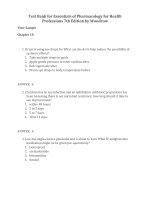Ebook Essentials of pharmacology for anesthesia, pain medicine and critical care: Part 2
Bạn đang xem bản rút gọn của tài liệu. Xem và tải ngay bản đầy đủ của tài liệu tại đây (7.11 MB, 519 trang )
Chapter 22
Histamine Modulators
Michael Yarborough and Judy G. Johnson
Contents
Introduction ..............................................................................................................................
Drug Class and Mechanism of Action .....................................................................................
Indications and Clinical Pearls.................................................................................................
Drug Interactions/Side Effects/Black Box Warnings...............................................................
Cardiac Effects ...................................................................................................................
CNS Effects........................................................................................................................
Summary ..................................................................................................................................
Chemical Structures .................................................................................................................
References ................................................................................................................................
365
366
367
374
374
375
377
377
378
Introduction
Discovery of certain chemicals to counteract the effects of histamine occurred in the
early twentieth century. The development of a drug that would alleviate allergic reactions such as itchy, watery eyes, and a runny nose from a cold or hay fever had an
astronomical effect on the medical community. By the 1950s, antihistamines were
being mass-produced in the USA and prescribed extensively as the drug of choice for
those suffering from allergies. The public perceived antihistamines as the “wonder
drug” and with the misconception that it was a “cure all” to the common cold.
Eventually, scientist began to discover additional indications for the use of antihistamines. These compounds continue to be one of the most universal drugs lining the
shelves of local pharmacies. However, the plethora of roles that antihistamines play
in the treatment of the human condition is much more extensive, including suppression of allergy symptoms, sedative agents, and antiemetic actions to name a few.
M. Yarborough, MD
Department of Anesthesiology, Tulane Medical Center, New Orleans, LA, USA
e-mail:
J.G. Johnson, MD (*)
Department of Anesthesiology, Louisiana State University, New Orleans, LA, USA
A.D. Kaye et al. (eds.), Essentials of Pharmacology for Anesthesia,
Pain Medicine, and Critical Care, DOI 10.1007/978-1-4614-8948-1_22,
© Springer Science+Business Media New York 2015
365
366
M. Yarborough and J.G. Johnson
Drug Class and Mechanism of Action
Histamine is involved in local immune responses as well as regulation of physiologic functions in the gut. It can also act as a neurotransmitter. Histamine is made
and released by different cells, i.e., basophils, mast cells, platelets, histaminergic
neurons, lymphocytes, and enterochromaffin cells. It is stored in vesicles or granules awaiting release upon stimulation [1]. As part of an immune response to foreign pathogens, histamine increases the permeability of capillaries to white blood
cells and other proteins in order to allow them to engage foreign invaders in the
infected tissues. Clinical effects of histamine result in increased vascular permeability and leakage of plasma proteins, causing fluid to escape from capillaries into the
tissues [2]. This leads to the classic symptoms of an allergic reaction such as a localized rash, itching, puffy and watery eyes, nasal congestion, and rhinorrhea.
There are four known human histamine receptors that have been identified
(Table 22.1). These receptors belong to the G-protein-coupled receptors family.
They are signified as H1, H2, H3, and H4. Stimulation of the H1 receptor can activate
intracellular signaling pathways leading to the development of classic allergic
symptoms [1].
Historically, antihistamines were noted to cause a parallel displacement in the
histamine concentration/response. This behavior was consistent with a competitive
inhibition for histamine receptors, lending to the classification as the H1 receptor
antagonists. With further research, it was found that the antihistamines are in the
class that are now called inverse agonists
Table 22.1 Histamine receptors classification
Receptor
type
Tissue location
H1
Airway and vascular smooth muscles,
endothelial, central nervous system
(nerve cells), neutrophils, eosinophils,
monocytes
H2
H3
H4
Nerve cells, vascular smooth muscles and
parietal cells, hepatocytes, endothelial
cells, epithelial cells, neutrophils,
eosinophils, monocytes
Histaminergic neurons, eosinophils. Found
primarily in the central nervous system,
low expression in peripheral tissues
High expression in bone marrow and
peripheral hematopoietic cells. Low
expression in nerve cells, hepatocytes,
spleen, thymus, small intestine, colon,
heart
Intracellular function
Cause bronchial smooth muscle
contraction, separation of
endothelial cells causing hives,
pain, and itching. Allergic reaction
symptoms, motion sickness, and
regulation of sleep
Vasodilation and stimulation of gastric
acid secretion
Inhibits histamine release and
synthesis. Decreases release of
serotonin, acetylcholine, and
norepinephrine
Stimulates chemotaxis of eosinophils
and mast cells
22 Histamine Modulators
367
Table 22.2 Chemical classifications of antihistamines
Alkylamines
Ethanolamines
Ethylenediamines
Phenothiazines
Piperidines
Piperazines
Brompheniramine, chlorpheniramine, dexchlorpheniramine, pheniramine,
triprolidine
Carbinoxamine, clemastine, dimenhydrinate, diphenhydramine, doxylamine,
orphenadrine
Pyrilamine, tripelennamine
Methdilazine, promethazine, trimeprazine
Cyproheptadine, fexofenadine, desloratadine, loratadine
Terfenadine and astemizole recalled by FDA
Cetirizine, cyclizine, hydroxyzine, levocetirizine, meclizine
Modified from Nicolas [5]
As an inverse agonist, the compound preferably binds to the inactive state of the
histamine receptor, stabilizing the receptor in the inactive conformation, and moves
the equilibrium shift in the direction of the inactive state. Since H1 antihistamines
have been discovered as inverse agonist, the adoption of the term “H1 antihistamines” has been contemplated [1, 3]. The chemical structure of antihistamines can
be varied (Table 22.2).
Indications and Clinical Pearls
H1 antihistamines are used to relieve or prevent allergy symptoms. Suppression of
allergic inflammation in the mucous membranes and reduction of the size of wheal
(swelling) and flare (vasodilation) response will help alleviate symptoms such as
itching, rhinorrhea, sneezing, urticaria, and congestion [4]. The effect on airway
smooth muscle is that of bronchodilation. H1 antihistamines can be grouped into
two classifications: First-generation (sedative) antihistamines and second-generation
(nonsedating) antihistamines. First-generation H1 antihistamines include chlorpheniramine (Chlor-Trimeton), clemastine (Tavist), dexchlorpheniramine (Polaramine),
dimenhydrinate (Dramamine), dimetindene (Fenistil), doxylamine (Unisom – used
as the sedative in NyQuil), diphenhydramine (Benadryl), hydroxyzine (Vistaril),
meclizine (Antivert), orphenadrine (Norflex), pheniramine (Avil), and promethazine (Phenergan).
First-generation H1 antihistamines cross the blood-brain barrier due to their lipophilic molecular structure leading to the possible unwarranted effect of sedation.
Adverse reactions may be due to their inhibition on muscarinic, serotonergic, and
adrenergic receptors (Table 22.3). Reports of toxicity with overdose, whether intentional or accidental, have been reported.
Antiemetic effects may be elicited due to blockade of the histaminergic signal
from the vestibular nucleus to the vomiting center in the medulla [6]. Clinical uses
can extend beyond the treatment of allergic symptoms to the treatment of vestibular
disorders, sedatives, sleeping aids, and antiemetics. These agents are usually administered in three to four daily doses (Table 22.4).
368
M. Yarborough and J.G. Johnson
Table 22.3 H1 antihistamine adverse effects on various receptors
Adverse effect of first-generation H1 antihistamines
H1 receptor
CNS neurotransmission reduction, sedation, cognitive and
neuropsychomotor performance reduction, appetite↑
Muscarinic
Tachycardia, urinary retention
receptor
Hypotension, dizziness, reflex tachycardia
α-adrenergic
receptor
Appetite increase
Serotonin receptor
Cardiac channels
Prolongation of the QT interval, ventricular arrhythmia
Modified from [1, 5]
Second-generation antihistamines include acrivastine (Semprex), cetirizine
(Zyrtec), desloratadine (Clarinex), ebastine (Kestine), fexofenadine (Allegra), levocetirizine (Xyzal), and loratadine (Claritin). The Food and Drug Administration
(FDA) removed terfenadine (Seldane) and astemizole (Hismanal) from the US
market.
With development over the last two decades of the newer second-generation H1
antihistamines, advantages over the earlier drugs have been seen. Less sedation and
fewer anticholinergic side effects have lead to their significant advance in the pharmacologic treatment of allergic symptoms. Second-generation H1 antihistamines
differ from the first generation because of their high specificity and affinity for
peripheral H1 receptors [5]. These newer advanced drugs have much less effect on
the central nervous system and do not have sedating effects (Table 22.5). They are
rapidly absorbed and peak plasma concentrations are reached after 1–3 h. Once- to
possibly twice-daily dosing administration schedules are recommended. Of note,
most show significant renal clearance lending to the need to adjust dosing in patients
with renal impairment.
Suppression of stomach acid secretion occurs due to prevention of histamine
action on the H2 receptor found in the gastric mucosa parietal cells. Like the H1
antihistamines, the H2 antihistamines are inverse agonist rather that true receptor
antagonists. Their uses are for treatment of acid-related gastrointestinal conditions,
i.e., dyspepsia, gastroesophageal reflux, and peptic ulcer disease. Prevention of
stress ulcers has also been described along with a decrease in vascular permeability.
H2 receptors are also found in smooth muscle, cardiac cells, and the central nervous
system [6].
All four H2 blockers, including cimetidine, ranitidine, famotidine, and nizatidine,
are available over the counter in the USA. Most are well tolerated due to the selectivity. They do not block H1 receptors or have antimuscarinic activity (Table 22.6).
©
Norflex
©
Orphenadrine
Vistaril
©
Hydroxyzine
Diphenhydramine Benadryl
Drug
Dosage
25–50 mg PO q4–6 h; 10–50 mg
IV/IM
(total of 400 mg/day)
(Tabs, capsules, liquid, rapidly
dissolving tab or strip, IV)
25 mg po TID–QID
25–100 mg IM q 4–6 h
(Capsules, oral suspension, IM)
60–100 mg PO q 8 h, 60 mg PO, IM,
IV for Parkinson’s disease
(Tabs, oral solution, IM/IV)
Treatment usage
Allergy symptoms
Motion sickness
Insomnia
Dystonia in early
Parkinson’s disease
Allergy symptoms
Nausea/vomiting
Motion sickness
Anxiety
Alcohol withdrawal
Pain (muscle spasms),
headache
Migraines
Parkinson’s disease
Table 22.4 First-generation H1 antihistamines
Special
precautions
Normal
Normal
Special
diet
Normal
Drowsiness
Dizziness
Restlessness
Constipation
Increase in chest congestion
Urinary retention
Euphoria
Side effects
Dry mouth
Drowsiness
Dizziness
Nausea/vomiting
Constipation
Increase in chest congestion
Headaches photosensitivity
Urinary retention
Dry mouth drowsiness
Dizziness
Chest congestion
Headache
Muscle weakness
Increased anxiety
Dry mouth
(continued)
Prescribed
Prescribed
Availability
Over the
counter
22 Histamine Modulators
369
Modified from Lin [6]
Phenergan
Motion sickness
Insomnia
Promethazine
©
6.25–12.5 mg PO qd, 12.5–25 mg IV Precaution
q 4–6 h (tabs, rectal supp, IV)
in the
elderly
and
children
Not to be
given to
children
under
2 years
of age
Allergy symptoms
Special
precautions
Dosage
Treatment usage
Drug
Table 22.4 (continued)
Normal
Special
diet
Side effects
Drowsiness
Nausea/vomiting
Blurred vision
Nightmares
Nervousness
Restless, hyperactivity
Respiratory depression
Confusion
Dry mouth
Availability
Prescribed
370
M. Yarborough and J.G. Johnson
Xyzal
©
Levocetirizine
Allegra
©
Fexofenadine
Clarinex
©
Desloratadine
Zyrtec
©
Cetirizine
Drug
5 mg PO q day
(Tablets, orally disintegrating
tabs, syrup)
Seasonal allergic rhinitis
60 mg PO BID or 180 mg PO q
day
(Tablet, orally disintegrating
tabs, suspension)
5 mg PO q day
(Tablet, oral solution)
Seasonal allergic rhinitis
Chronic idiopathic urticaria
Motion sickness
Insomnia
Seasonal allergic rhinitis
Chronic idiopathic urticaria
Chronic idiopathic urticaria
Dosage
5–10 mg PO q day (tablets,
chewable tabs, syrup)
Treatment usage
Seasonal allergic rhinitis
Chronic idiopathic urticaria
Table 22.5 Second-generation H1 antihistamines
Dosing adjustment
for renal
impairment
Dosing adjustment
for renal
impairment
Dosing adjustment
for renal or
hepatic
impairment
Special precautions
Dosing adjustment
for renal,
hepatic
impairment and
the elderly
Normal
Decreased absorption
from fruit juices:
grapefruit, orange,
and apple
Normal
Special diet
Normal
Side effects
Somnolence
Fatigue
Dry mouth
Pharyngitis
Stomach pain
Diarrhea
Vomiting
Pharyngitis
Dry mouth
Myalgia
Fatigue
Somnolence
Headache
Dry mouth
Nausea
Dizziness
Weakness
Headache
Aggression
Dry mouth
Pharyngitis
Somnolence
Fatigue
Nasopharyngitis
(continued)
Prescribed
Over the
counter
Prescribed
Availability
Over the
counter
22 Histamine Modulators
371
Dosage
10 mg PO q day
(Tablet, orally disintegrating
tabs, syrup)
Treatment usage
Seasonal allergic rhinitis
Chronic idiopathic urticaria
Modified from Lin [6]
Claritin
©
Loratadine
Drug
Table 22.5 (continued)
Dosing adjustment
for hepatic and
renal
impairment
Special precautions
Increased plasma levels
noted with CYP
inhibitors
Special diet
Headache
Dry mouth
Somnolence
Blurred vision
Fatigue
Side effects
Over the
counter
Availability
372
M. Yarborough and J.G. Johnson
Dyspepsia
PUD
GERD
Prevention of stress ulcers
(Experimental use with
weight gain)
Dyspepsia
PUD
GERD
Prevention of stress ulcers
Dyspepsia
PUD
GERD
Prevention of stress ulcers
Treatment usage
Dyspepsia
Peptic ulcer disease (PUD)
Gastroesophageal reflux
(GERD)
Prevention of stress ulcers
Modified from Lin [6]
Axid
©
Nizatidine
Zantac
©
Ranitidine
Pepcid
©
Famotidine
Tagamet
©
Cimetidine
Drug
Table 22.6 H2 antihistamines
Dosage
300 mg PO q day –
twice daily for
OTC, 300 mg q
6–8 h PO or
maximum 2.4 g/
day
(Tablet, liquid, IV/
IM)
20 mg PO q day,
twice daily for
OTC, 20 mg up to
four times/day
(tablet, chewable
tabs, capsule,
liquid, IV)
150 mg PO twice
daily, 50 mg IV/
IM q 6–8 h (tablet,
effervescent tabs,
granules, syrup,
capsule, IV)
150 mg PO q day,
twice daily
(tablets, capsule)
30–60 min
prior to
meals and
bedtime
15–60 min
prior to
meals and
bedtime
Special diet
30 min prior
to meals
and
bedtime
Does not interfere
30–60 min
with hepatic
prior to
oxidation,
meals and
increase in liver
bedtime
enzymes noted in
some patients.
Does not interfere
with hepatic
oxidation
Does not interfere
with hepatic
oxidation
Special precautions
Inhibits hepatic
oxidative
metabolism by
most cytochrome
P450 enzymes
leading to drug
interactions
Headache
Dizziness
Constipation
Diarrhea
Sweating
Stomach pain
Headache
Diarrhea
Constipation
Nausea/vomiting
Stomach pain
Headache
Dizziness
Constipation
Diarrhea
Dizziness
Drowsiness
Depression
Side effects
Confusion
Headache
Diarrhea
Over the counter, some
prescribed
formulations, last
H2 antihistamine
before “proton
pump inhibitors”
Over the counter, some
prescribed
formulations
Over the counter, some
prescribed
formulations
Availability
Over the counter, some
prescribed
formulations
22 Histamine Modulators
373
374
M. Yarborough and J.G. Johnson
Drug Interactions/Side Effects/Black Box Warnings
Cardiac Effects
Concerns over the development of ventricular arrhythmias have been reported, and
the metabolic profile and susceptibility with other drug interactions among some of
these second-generation compounds exist. Potassium channels in the heart may be
blocked by various substrates lending to a prolongation of the QT interval of the
electrocardiogram resulting in lethal arrhythmias [7].
Metabolism is emerging as an important part of second-generation antihistamines. In order to understand the risk of cardiac arrhythmias, an understanding of
CYP3A4 antihistamine metabolism and other drug interactions, i.e., inhibitors, substrates, and inducers, must be understood. Compounds such as the second-generation
antihistamines have very low plasma levels secondary to high tissue uptake and
first-pass liver metabolism. These compounds are metabolized to pharmacologically active agents. The metabolic pathway is mediated primarily by CYP3A4, an
isoenzyme belonging to the cytochrome P450 (CYP) superfamily. CYP3A4 is
responsible for 30 % of total CYP metabolism in the liver and 70 % in the intestine.
Besides antihistamines, CYP3A4 can accommodate a large variety of structurally
diverse exogenous and endogenous compounds. It should be noted the CYP3A4 can
be inhibited or induced by a number of drugs; hence it is implicated in many drug
interactions [1, 5].
An example of potential risk is found in the concomitant usage of erythromycin
and ketoconazole with terfenadine. These compounds hinder the metabolic clearance of terfenadine, thereby inducing its accumulation triggering a cardiac response.
These effects are thought to be due to the potency of terfenadine to block cardiac
potassium channels leading to QT interval prolongation and possible fatal arrhythmias. Subsequent investigations have shown other substrates and/or inhibitors have
lead to cardiac events with terfenadine. The FDA removed this drug from the US
market in 1997. Astemizole also has been shown to have arrhythmogenic potential
[5] resulting in its withdrawal from the US market in 1999.
In contrast, cetirizine, epinastine, and fexofenadine are on the other side of the
metabolic hurdle, and most of the dose is eliminated as unchanged drug. No active
metabolites have been reported for these agents [1].
Grapefruit juice and tonic water containing quinine may interfere with antihistamine metabolism by inhibition of CYP3A4-dependent first-pass metabolism at the
intestinal level. FDA warnings about interactions with astemizole and quinine have
been established. As for grapefruit juice, the magnitude of the interaction may be
unpredictable and dependent on factors of individual susceptibility, type and amount
of juice consumed, and timing of administration [1, 5, 6].
In addition, variability among humans with the lowest CYP activities may be at
risk for development of high concentrations of antihistamines even with recommended dosing and no interfering drugs. Metabolic pathways and concomitant drug
usage may affect the safety of these drugs. Terfenadine and astemizole are examples
22 Histamine Modulators
375
of potential concern. It has been suggested that three questions should guide the
physician when prescribing H1 antihistamines [7]:
• Is there a history of organic heart disease, cardiac arrhythmias, electrolyte disturbances, or hepatic disease?
• Is there a possibility of concomitant use of macrolides, anti-arrhythmics, antipsychotics, opiates, imidazole compounds, or migraine medications?
• Are there any special diets requiring grapefruit juice or tonic water?
CNS Effects
Studies have shown that CNS impairment such as somnolence or cognitive and
psychomotor impairment can occur when cerebral H1 receptors are at least 50 %
occupied. Cyproheptadine unlike most antihistamines antagonizes serotonin receptors. With only weak anticholinergic properties, its ability to compete with serotonin at receptor sites produces both antiemetic effects and stimulates appetite.
Orphenadrine binds to both H1 and NMDA receptors. The medication is marketed
for use in acute, painful, musculoskeletal conditions due to its reported relaxing
effect on skeletal muscle spasms [8, 9]. Chlorpheniramine plasma levels showed
cerebral H1 receptor occupation exceeding 50 % resulting in perceived central
adverse manifestations. For an H1 antihistamine to be considered as not having sedative effects, they must not exceed 20 % cerebral H1 receptor occupation when using
maximum dosages [1]. Second-generation H1 antihistamines do not appear to have
significant receptor occupation leading to adverse CNS effects. Tolerance of adverse
CNS effects among these first-generation H1 antihistamines has been found to
occur after consecutive use over 5 days.
In the CNS, histamine (H1 and H2) modulates activities such as arousal, thermoregulation, neuroendocrine, and cognitive functions. Blockade of central H2 receptors can cause delirium, confusion, agitation, and rarely seizures. H2 antihistamines
rarely cause CNS toxicity even in large dosing regimens.
Cimetidine is the exception and has been implicated in adverse drug reactions
including hypotension, headaches, dizziness, confusion, loss of libido, and impotence in males. A study of African Americans found that long-term use of H2 blockers appeared to increase the risk of cognitive impairment [10]. A relationship
between H2 blocker utilization in patients over 65 and depression has been reported.
Age
Second-generation H1 antihistamines are effective with safety profiles superior in
the treatment of allergic symptoms [11]. Risk of psychomotor impairment may have
negative impacts on children. Concern over the sedative effects related to many of
the first-generation antihistamine agents should prompt caution in the elderly and
376
M. Yarborough and J.G. Johnson
children. Hydroxyzine and chlorpheniramine have been accepted for children over
the age of two. Desloratadine, fexofenadine, and levocetirizine can be used in children between the ages of 1–2 [1].
Gestation and Lactation
The FDA has listed some H1 first- and second-generation antihistamines as Category
B, which may be used in the first trimester of pregnancy. Third trimester antihistamines usage has been associated with a risk of neonatal seizures, and, therefore,
Category C compounds such as diphenhydramine, hydroxyzine, clemastine, fexofenadine, and ebastine should be avoided. Advisements from drug manufacturers
have been published warning lactating mothers to avoid H1 antihistamine use due to
infant irritability, sedation, and a reduction in the production of breast milk. Some
second-generation antihistamines have been noted to have minimal amounts present
in the mother’s milk supply and can be used without concern [11].
The H2 antagonists cimetidine, ranitidine, and famotidine have been assigned
Category B by the FDA in association with pregnancy, while nizatidine was assigned
Category C. In a recent meta-analysis, it was felt that the use of H2 antagonists was
considered safe for the treatment of acid reflux and managing heartburn in pregnancy [12].
Metabolism
With regard to pharmacokinetics, cimetidine also inhibits hepatic oxidative metabolism through the liver cytochrome P450 pathway. By altering the metabolism of
other drugs through enzyme pathways, cimetidine can increase the serum levels
leading to possible toxicity. A variety of drugs including warfarin, propranolol,
labetalol, metoprolol, phenytoin, lidocaine, benzodiazepines, quinidine, theophylline, certain tricyclic antidepressants, and serotonin reuptake inhibitors can be
affected [13]. The more recently developed H2 receptor antagonists are less likely to
alter CYP metabolism. Ranitidine is not as potent a CYP inhibitor but still may
interact with warfarin, theophylline, phenytoin, metoprolol, and midazolam [14].
Famotidine has little effect on the CYP system and appears to have no significant
interactions. Rare cases of bradycardia, tachycardia, and A-V heart block have been
reported with H2 receptor antagonists.
Black Box Warnings
In 2009, the US Food and Drug Administration began telling manufacturers
of the drug promethazine to include a boxed warning regarding the injectable
form of the drug. The warning, under FDA’s authority to require
22 Histamine Modulators
377
safety-labeling changes, highlights the risk of serious tissue injury when this
drug is administered incorrectly. Promethazine should neither be administered into an artery nor administered under the skin because of the risk of
severe tissue injury, including gangrene, the boxed warning says. There is also
a risk that the drug can leach out from the vein during intravenous administration and cause serious damage to the surrounding tissue. As a result of these
risks, the preferred route of administration is injecting the drug deep into the
muscle [15]. An additional FDA safety alert from April of 2006 reminded
physicians of the antihistamines ability to produce fatal respiratory depression
and that the medication is not intended to be used in children under 2 years of
age.
Summary
Histamine receptor modulators are some of the most utilized, prescribed and over
the counter, medications in the world. Their varied uses and relatively limited side
effect profiles make them readily available either by prescription or via over-thecounter preparations. This prevalence makes it paramount for practitioners to understand the mechanism of actions of these medications and the potentially undesirable
and dangerous side effects including cardiac manifestations, nervous system interactions, alterations in the metabolism of other medications, and age-related side
effects to name a few. Remarkably, with all of the varied medications and chemical
structures, there is only one histamine modulator that has received a box warning
from the FDA, promethazine. In addition, that warning is related to the delivery of
the injectable medication.
Chemical Structures
CI
N
N
Chemical Structure
22.1 Chlorphenamine
I
378
M. Yarborough and J.G. Johnson
Chemical Structure
22.2 Hydroxyzine
CI
N
N
Chemical Structure
22.3 Promethazine
OH
O
S
N
CH3
N
CH3
H3C
Chemical Structure
22.4 Cimetidine
N
S
NH
N
N
HN
HN
Chemical Structure
22.5 Ranitidine
NO2
CH3
H3C
S
N
O
N
H
N CH3
H
References
1. Criado PR, Criado RFJ, Maruta CW, et al. Histamine, histamine receptors and antihistamines:
new concepts. Braz Annals Dermatol. 2010;85(2):195–210.
2. Jutel M, Blaser K, Akdis CA. Histamine in chronic allergic responses. J Invest Allergy Clin
Immunol. 2005;15:1–8.
3. Leurs R, Church MK, Taglialatela M. H1-antihistamines: inverse agonism, anti-inflammatory
actions and cardiac effects. Clin Exp Allergy. 2002;32:489–98.
22 Histamine Modulators
379
4. Monroe E, Daly A, Shalhoub R M.D. Appraisal of the validity of histamine-induced wheal and
flare is used to predict the clinical efficacy of antihistamines. J Allergy Clin Immunol.
1997;99(2):S789–806.
5. Nicolas JM. The metabolic profile of second-generation antihistamines. Allergy. 2000;55
Suppl 60:46–52.
6. Lin S. Antihistamines. In: Sinatra R, Jahr J, Watkins-Pitchford J, editors. The essence of analgesia and analgesics. New York: Cambridge University Press; 2011. p. 391–6.
7. Davila I, Sastre J, Bartra J, del Cuvillo A, Jauregui I, Montoro J, et al. Effect of H1 antihistamines upon the cardiovascular system. J Investig Allergol Clin Immunol. 2006;16 Suppl
1:13–23.
8. Rumore MM, Schlichting DA. Analgesic effects of antihistaminics. Life Sci.
1985;36(5):403–16.
9. Kornhuber J, Parson CG, Hartnamm S, et al. Orphenadrine is an uncompetitive N-methyl-Daspartate (NMDA) receptor antagonist: binding and patch clamp studies. J Neural Transm Gen
Sect. 1995;102(3):237–46.
10. Boustani M, Hall KS, Lane KA, et al. The association between cognition and histamine-2
receptor antagonists in African Americans. J Am Geriatr Soc. 2007;55(8):1248–53.
11. Powell RJ, Du Toit GI, Siddique N, Leech SC, Dixon TA, Clark AT, British Society for Allergy
and Clinical Immunology (BSACI), et al. BSACI guidelines for the management of chronic
urticaria and angio-oedema. Clin Exp Allergy. 2007;37:631–50.
12. Gill SK, O’Brien L, Koren G. The safety of histamine 2 (H2) blockers in pregnancy: a metaanalysis. Dig Dis Sci. 2009;54:1835–8.
13. Humphries TJ, Merritt GJ. Review article: drug interactions with agents used to treat acidrelated diseases. Aliment Pharmacol Ther. 1999;13 Suppl 3:18–26.
14. Kirch W, Hoensch H, Janisch HD. Interactions and non-interactions with ranitidine. Clin
Pharmacokinet. 1984;9(6):493–510.
15. U.S. Food and Drug Administration[Internet]. Postmarket drug safety information for patients
and providers. Information for healthcare professionals – intravenous promethazine and severe
tissue injury, including gangrene. (updated 09/16/2009). Available from />Drugs/DrugSafety/PostmarketDrugSafetyInformationforPatientsandProviders/
DrugSafetyInformationforHeathcareProfessionals/ucm182169.htm.
Chapter 23
Central Nervous System Stimulants
Eric S. Hsu
Contents
Introduction ..............................................................................................................................
Drug Class and Mechanism of Action .....................................................................................
Indications/Clinical Pearls .......................................................................................................
Dosing Options ........................................................................................................................
Amphetamine (Adderall XR) .............................................................................................
Modafinil (Provigil) ...........................................................................................................
Armodafinil (Nuvigil) ........................................................................................................
Caffeine ..............................................................................................................................
Methylphenidate (Ritalin) ..................................................................................................
Sodium Oxybate (Xyrem) ..................................................................................................
Drug Interactions .....................................................................................................................
Modafinil (Provigil) ...........................................................................................................
Armodafinil (Nuvigil) ........................................................................................................
Side Effects/Black Box Warnings ............................................................................................
Anesthesia Considerations .......................................................................................................
Summary ..................................................................................................................................
Drug Dependence.....................................................................................................................
Chemical Structures .................................................................................................................
References ................................................................................................................................
381
382
385
386
386
386
386
387
387
388
388
389
389
390
392
392
393
394
395
Introduction
It has been estimated that 1.5 % of the general population complains of excessive
daytime sleepiness or excessive sleep amounts consistent with a hypersomnia
disorder. Narcolepsy is a neurological disorder affecting the regulation of sleep and
E.S. Hsu, MD
Anesthesiology Pain Medicine Center, UCLA–School of Medicine, University of California,
Los Angeles, CA, USA
e-mail:
A.D. Kaye et al. (eds.), Essentials of Pharmacology for Anesthesia,
Pain Medicine, and Critical Care, DOI 10.1007/978-1-4614-8948-1_23,
© Springer Science+Business Media New York 2015
381
382
E.S. Hsu
wakefulness. It is characterized by excessive daytime sleepiness, cataplexy (sudden
temporary inability to move), and other rapid eye movement (REM) sleep-associated
manifestations (e.g., hypnagogic hallucinations and sleep paralysis).
The diagnoses of primary hypersomnolence are made after eliminating sleep
deprivation, sleep apnea, disturbed nocturnal sleep, and psychiatric comorbidities as
the main cause of daytime sleepiness.
Clinical syndromes with primary hypersomnolence can be divided into three
groups according to the Diagnostic and Statistical Manual of Mental Disorders, 5th
edition (DSM-V): (1) narcolepsy caused by hypocretin (orexin) deficiency, a disorder associated with human leukocyte antigen (HLA) marker DQB1*06:02 and
believed to be autoimmune (almost all cases with cataplexy); (2) Kleine-Levin syndrome (KLS), a periodic hypersomnia associated with cognitive and behavioral
abnormalities (KLS are considered a separate entity with separate therapeutic protocols); and (3) non-hypocretin-related hypersomnia syndromes (generally without
cataplexy) which are diagnoses of exclusion. This is the most challenging and the
most frequent diagnosis [1].
Narcolepsy caused by hypocretin deficiency is called “type 1 narcolepsy” in the
International Sleep Disorder Classification, 3rd edition (ICSD3), while other
hypersomnias (not likely due to hypocretin abnormalities) are subdivided into “type
2 narcolepsy” in the presence of a positive multiple sleep latency test (MSLT) with
multiple sleep-onset REM periods (SOREMPs) versus idiopathic hypersomnias
otherwise [2].
Shift work disorder (SWD) is characterized by symptoms of excessive sleepiness
during work hours or insomnia during allotted daytime sleep hours, as well as by a
disruption of the circadian rhythm. Many shift workers with SWD experience significant social, behavioral, and health problems as a result of this disorder. SWD is
often associated with a higher risk of occupational and motor vehicle accidents.
SWD in health-care providers may present additional risk for public health [3].
A diagnosis of attention deficit hyperactivity disorder (ADHD; DSM-IV) implies
the presence of hyperactive-impulsive symptoms that caused impairment and were
present before age 7 years. The symptoms must cause clinically significant impairment, e.g., in social, academic, or occupational functioning, and be present in two
or more settings, e.g., school (or work) and at home.
Drug Class and Mechanism of Action
Amphetamine (Adderall) is a CNS stimulant. The chemical name for amphetamine
is 1-phenylpropan-2-amine. The molecular formula is C9H13N. See Chemical
Structure 23.1 at the end of the chapter.
Amphetamine (Adderall) increases monoamine release (such as dopamine, norepinephrine, and serotonin). Primary effects of amphetamine may be due to reverse
efflux of dopamine through the dopamine transporter (DAT). Higher doses of
amphetamine interfere with monoamine storage through the vesicular monoamine
23 Central Nervous System Stimulants
383
transporter (VMAT) and other effects. The D-isomer is more specific for dopamine
transmission and is a better stimulant compound. Some effects on cataplexy (especially for the L-isomer), secondary to adrenergic effects, occur at higher doses.
Amphetamine is available as racemic mixture or as pure D-isomer and various timerelease formulations. Addiction potential is high for immediate-release formulation.
High doses cause increased blood pressure and possible cardiac complications.
Modafinil (Provigil) is a wakefulness-promoting agent for oral administration.
Modafinil is a racemic compound. The chemical name for modafinil is 2-[(diphenylmethyl) sulfinyl] acetamide. The molecular formula is C15H15NO2S and the
molecular weight is 273.35. See Chemical Structure 23.2 at the end of the chapter.
The precise mechanism(s) through which modafinil promotes wakefulness is
unknown. Modafinil has wake-promoting actions similar to sympathomimetic
agents like amphetamine and methylphenidate. However, the pharmacologic profile
of modafinil is not identical to sympathomimetic amines. Modafinil has weak to
negligible interactions with receptors for norepinephrine, serotonin, dopamine,
gamma-aminobutyric acid (GABA), adenosine, histamine-3, melatonin, and benzodiazepines. Modafinil does not inhibit the activities of monoamine oxidase (MAO)-B
or phosphodiesterases II–V. Modafinil-induced wakefulness can be attenuated by
the alpha (α) 1-adrenergic receptor antagonist prazosin; however, modafinil is inactive in other in vitro assay systems known to be responsive to a-adrenergic agonists,
such as the rat vas deferens preparation.
Modafinil is not a direct- or indirect-acting dopamine receptor agonist. However,
modafinil binds to the dopamine transporter and inhibits dopamine reuptake in vitro.
This activity has been associated in vivo with increased extracellular dopamine levels in some brain regions of animals. In genetically engineered mice lacking the
dopamine transporter (DAT), modafinil lacked wake-promoting activity, suggesting
that this activity was DAT-dependent.
However, the wake-promoting effects of modafinil, unlike those of amphetamine,
were not antagonized by the dopamine receptor antagonist haloperidol in rats.
In the cat, equal wakefulness-promoting doses of methylphenidate and amphetamine increased neuronal activation throughout the brain. Modafinil at an equivalent wakefulness-promoting dose selectively and prominently increased neuronal
activation in more discrete regions of the brain. The relationship of this finding in
cats to the effects of modafinil in humans is unknown.
Modafinil produces psychoactive and euphoric effects such as alterations in
mood, perception, thinking, and feelings typical of other CNS stimulants in humans.
Modafinil has two major metabolites, modafinil acid and modafinil sulfone, that do
not appear to contribute to the CNS-activating properties.
Armodafinil (Nuvigil) is a wakefulness-promoting agent for oral administration.
Armodafinil is the R-enantiomer of modafinil which is a mixture of the R- and
S-enantiomers. The chemical name for armodafinil is 2-[(R)-(diphenylmethyl) sulfinyl] acetamide. The molecular formula is C15H15NO2S and the molecular weight
is 273.35. See Chemical Structure 23.3 at the end of the chapter.
The precise mechanism(s) through which armodafinil (R-enantiomer) or
modafinil (mixture of R- and S-enantiomers) promotes wakefulness is unknown.
384
E.S. Hsu
However, armodafinil and modafinil have shown similar pharmacological properties
in nonclinical animal and in vitro studies. At pharmacologically relevant concentrations, armodafinil does not bind to or inhibit several receptors and enzymes potentially relevant for sleep/wake regulation.
The chemical name for Caffeine is 1, 3, 7-trimethylxanthine. Its molecular formula is C8H10N4O2. See Chemical Structure 23.4 at the end of the chapter.
Caffeine is a widely consumed stimulant and treatment of hypersomnia. The
wake-promoting potency of caffeine is often not strong enough yet high doses may
induce side effects. Caffeine is an adenosine A1 and A2 receptor antagonist.
Caffeine is metabolized to paraxanthine, theobromine, and theophylline.
Paraxanthine is a central nervous stimulant and exhibits higher potency at A1 and
A2 receptors. Paraxanthine had lower toxicity and lesser anxiogenic effects than
caffeine as studied in Orexin/Ataxin-3 transgenic narcoleptic mice model [4].
Methylphenidate (Ritalin) hydrochloride is a mild central nervous system (CNS)
stimulant. It is available as tablets of 5, 10, and 20 mg for oral administration.
Ritalin-SR is available as sustained-release tablets of 20 mg for oral administration.
The chemical formula for methylphenidate is methyl α-phenyl-2-piperidineacetate
hydrochloride. The molecular formula is C14 H19 NO2. See Chemical Structure 23.5
at the end of the chapter.
The mode of action in man is not completely understood. Methylphenidate likely
activates the brain stem arousal system and cortex to produce its stimulant effect.
There is no specific evidence to establish the effect or mechanism in CNS how methylphenidate produces its mental and behavioral effects in children. It has short halflife. It is available as racemic mixture or as pure D-isomer and in various time-release
formulations. Addiction potential is notable for immediate-release methylphenidate.
Methylphenidate (Ritalin) blocks monoamine (such as dopamine, norepinephrine, serotonin) uptake in nonclinical animal and in vitro studies. There is no effect
on reverse efflux or on vesicular monoamine transporter (VMAT).
Atomoxetine (Strattera) HCl is a selective norepinephrine reuptake inhibitor.
Atomoxetine HCl is the R(-) isomer as determined by X-ray diffraction. The chemical name for atomoxetine is (-)-N-Methyl-3-phenyl-3-(o-tolyloxy)-propylamine
hydrochloride. The molecular formula is C17H21NO•HCl, which corresponds to a
molecular weight of 291.82. See Chemical Structure 23.6 at the end of the chapter.
The precise mechanism by which atomoxetine produces its therapeutic effects in
ADHD is unknown. It is thought to be related to selective inhibition of the presynaptic norepinephrine transporter, as determined in ex vivo uptake and neurotransmitter depletion studies.
Sodium oxybate, a CNS depressant, is the active ingredient in Xyrem. The chemical name for sodium oxybate is sodium 4-hydroxybutyrate. The molecular formula
is C4H7NaO3, and the molecular weight is 126.09. See Chemical Structure 23.7 at
the end of the chapter.
Sodium oxybate (Xyrem) is a CNS depressant. Sodium oxybate has therapeutic
effect on excessive daytime sleepiness. Its mechanism of action is unknown. Sodium
oxybate is the sodium salt of gamma hydroxybutyrate, an endogenous compound
and metabolite of the neurotransmitter gamma-aminobutyric acid (GABA).
23 Central Nervous System Stimulants
385
It is hypothesized that the therapeutic effects of sodium oxybate are mediated
through GABA-B actions at noradrenergic and dopaminergic neurons, as well as at
thalamocortical neurons. Sodium oxybate reduces dopamine release in nonclinical
animal and in vitro studies.
Indications/Clinical Pearls
Amphetamine (ADDERALL XR) is indicated for the treatment of ADHD:
• Children (ages 6–12): Efficacy was established in one 3-week outpatient, controlled trial and one analog classroom, controlled trial in children with ADHD.
• Adolescents (ages 13–17): Efficacy was established in one 4-week controlled
trial in adolescents with ADHD.
• Adults: Efficacy was established in one 4-week controlled trial in adults with
ADHD.
Modafinil (Provigil) is indicated to improve wakefulness in adult patients with
excessive sleepiness associated with narcolepsy, obstructive sleep apnea (OSA),
and shift work disorder (SWD). Modafinil is indicated as an adjunct to standard
treatment(s) for the underlying obstruction in OSA. Careful attention to the diagnosis and treatment of underlying sleep disorder(s) is of utmost importance in all cases
of excessive sleepiness. A maximal effort to treat with continuous positive airway
pressure (CPAP) for an adequate period of time should be made prior to initiating
modafinil. The encouragement and periodic assessment of CPAP compliance is necessary, while modafinil is used as adjunctive treatment.
The effectiveness of modafinil in long-term use (greater than 9 weeks in narcolepsy
clinical trials and 12 weeks in OSA and SWD clinical trials) has not been systematically evaluated in placebo-controlled trials. Periodical reevaluation is recommended
for long-term use of modafinil in patients with narcolepsy, OSA, or SWD.
Armodafinil (Nuvigil) is indicated to improve wakefulness in patients with
excessive sleepiness associated with OSA, narcolepsy, and SWD. In OSA,
armodafinil is indicated as an adjunct to standard treatment(s) for the underlying
obstruction. The effectiveness of armodafinil in long-term use (greater than
12 weeks) has not been systematically evaluated in placebo-controlled trials.
Periodical reevaluation of efficacy is highly recommended for long-term use of
armodafinil in narcolepsy, OSA, or SWD.
Caffeine has a potential role in promoting alertness during times of desired
wakefulness in persons with SWD or jet lag sleep disorder [5].
Methylphenidate (Ritalin) is indicated for attention deficit hyperactivity disorder
(ADHD; DSM-IV) and narcolepsy. Methylphenidate is indicated as an integral part of
a total treatment program on ADHD. It typically includes other remedial measures
(psychological, educational, and social) for a stabilizing effect in children with a behavioral syndrome characterized by the following group of developmentally inappropriate
symptoms: moderate-to-severe distractibility, short attention span, hyperactivity,
386
E.S. Hsu
emotional lability, and impulsivity. The diagnosis of ADHD should not be made with
definiteness when these symptoms are only of comparatively recent origin.
Atomoxetine (Strattera) is indicated for the treatment of ADHD. The efficacy of
atomoxetine capsules was established in seven clinical trials in outpatients with
ADHD: four 6–9-week trials in pediatric patients (ages 6–18), two 10-week trial in
adults, and one trial for maintenance in pediatrics (ages 6–15).
Sodium oxybate (Xyrem) oral solution is indicated for the treatment of cataplexy
in narcolepsy and excessive daytime sleepiness (EDS) in narcolepsy. Sodium oxybate may only be dispensed to patients enrolled in the Xyrem Success Program.
Sodium oxybate needs at minimum bi-nightly dosing with immediate effects on
disturbed nocturnal sleep. Therapeutic effects of sodium oxybate on cataplexy and
daytime sleepiness can be delayed weeks to months. Nausea, weight loss, and psychiatric complications are possible side effects. As for any sedative, use with caution in the presence of hypoventilation or sleep apnea.
Dosing Options
Amphetamine (Adderall XR)
• Pediatric patients (ages 6–17): 10 mg once daily in the morning. The maximum
dose for children 6–12 is 30 mg once daily.
• Adults: 20 mg once daily in the morning.
Modafinil (Provigil)
Modafinil is available as 100 and 200 mg as racemic mixture. It is administered
once or twice a day (morning and noon), with a maximum of 400 mg/day. It is also
available as R-modafinil (50, 150, and 250 mg) which is approximately twice more
potent than racemic modafinil per mg. Headache is a common side effect but is usually avoidable by increasing the dose slowly. It is advisable to monitor allergic side
effects due to modafinil notably in children. Modafinil has not been approved by
Food and Drug Administration (FDA) for pediatrics.
Armodafinil (Nuvigil)
The recommended dose of armodafinil for patients with obstructive sleep apnea
(OSA) or narcolepsy is 150 or 250 mg given as a single dose in the morning. There
is no consistent evidence that 250 mg/day of armodafinil confers additional benefit
beyond 150 mg/day in patients with OSA.
23 Central Nervous System Stimulants
387
The recommended dose of armodafinil for patients with shift work disorder
(SWD) is 150 mg given daily approximately 1 h prior to the start of their work shift.
Dosage adjustment should be considered for concomitant medications that are substrates for CYP3A4/5, such as steroidal contraceptives, triazolam, and cyclosporine.
Drugs that are largely eliminated via CYP2C19 metabolism, such as diazepam, propranolol, and phenytoin, may have prolonged elimination upon coadministration
with armodafinil and may require dosage reduction and monitoring for toxicity.
Armodafinil should be administered at a reduced dose in patients with severe
hepatic impairment. There is inadequate information to determine safety and efficacy of armodafinil dosing in patients with severe renal impairment.
In elderly patients, elimination of armodafinil and its metabolites may be reduced
as a consequence of aging. Therefore, consideration should be given to the use of
lower doses in elderly.
Caffeine
Caffeine increases nighttime alertness but has little effect on daytime sleep. It has
been recommended for patients with SWD. According to practice parameters from
the American Academy of Sleep Medicine (AASM), caffeine is recommended to
enhance alertness during the night shift in patients with SWD. In a study of healthy
adults, caffeine equivalent to 2–4 cups of coffee was shown to be effective in reducing sleepiness and improving alertness. The alerting effect of caffeine was described
as equivalent to a 3.5 h nap, and it persisted for 5.5–7.5 h [6].
In a study of healthy volunteers undergoing a simulated night-shift schedule for
five nights, caffeine decreased sleep tendency during the night shift compared with
placebo, and fewer subjects receiving caffeine were sleepy across the first three
nights of the study. A laboratory study of healthy subjects under conditions of simulated night shifts demonstrated that caffeine, alone or in combination with napping,
improved alertness and performance as measured by the Maintenance of Wakefulness
Test and Psychomotor Vigilance Task. In a related field study with shift workers
working night shifts or rotating shifts, caffeine plus napping improved performance
and decreased reports of sleepiness in the night-shift workers [7].
Methylphenidate (Ritalin)
Methylphenidate (Ritalin) may be more effective and potent than modafinil and low
cost. Methylphenidate can substitute for modafinil when using long-acting formulations of the racemic mixture of any single isomer typically 20–40 mg/day. Various
preparations and formulations can have substantially different interindividual
effects. As base preparation, immediate release (5–10 mg) can be helpful, either to
alleviate sleep drunkenness in hypersomnia, to bridge gaps in alertness during the
388
E.S. Hsu
daytime (postprandial dose), or to use when necessary in case of emergency (e.g.,
need to drive to the hospital)
Sodium Oxybate (Xyrem)
Administration of sodium oxybate at night is effective in consolidating sleep in
patients with disturbed sleep due to insomnia, excessive activity during rapid eye
movement sleep, hypnagogic hallucinations, and sleep paralysis. Effect of sodium
oxybate on cataplexy and daytime sleepiness is evident soon after treatment begins
and builds further along several weeks.
The recommended starting dose is 4.5 g (g) per night administered orally in two
equal, divided doses: 2.25 g at bedtime and 2.25 g taken 2.5–4 h later.
Increase the dose by 1.5 g per night at weekly intervals (additional 0.75 g at
bedtime and 0.75 g taken 2.5–4 h later) to the effective dose range of 6–9 g per night
orally. Doses higher than 9 g per night have not been studied and should not ordinarily be administered.
Take the first dose of sodium oxybate (Xyrem) at least 2 h after eating because
food significantly reduces the bioavailability of sodium oxybate.
Prepare both doses of sodium oxybate prior to bedtime. Prior to ingestion, each
dose of sodium oxybate should be diluted with approximately ¼ cup (approximately
60 mL) of water in the empty pharmacy vials provided. Patients should take sodium
oxybate while in bed and lie down immediately after dosing as sodium oxybate may
cause them to fall asleep abruptly without first feeling drowsy. Patients will often
fall asleep within 5–15 min of taking sodium oxybate, though the time it takes any
individual patient to fall asleep may vary from night to night. Therefore, patients
should remain in bed following ingestion of the first dose and should not
take the second dose until 2.5–4 h later. Patients may need to set an alarm to awaken
for the second dose.
Drug Interactions
Monoamine oxidase inhibitors (MAOI) antidepressants may slow amphetamine
metabolism. A variety of toxic neurological effects and malignant hyperpyrexia can
occur with fatal results. Do not administer amphetamine during or within 14 days
following the administration of MAOI.
Coadministration of amphetamine with gastrointestinal alkalinizing agents (such
as antacids) or urinary alkalinizing agents (acetazolamide, some thiazides) increases
blood levels and potentiates the actions of amphetamines. Gastrointestinal acidifying agents (e.g., guanethidine, reserpine, glutamic acid HCl, ascorbic acid) and urinary acidifying agents (e.g., ammonium chloride, sodium acid phosphate,
methenamine salts) may lower blood levels and efficacy of amphetamines.
23 Central Nervous System Stimulants
389
Amphetamines may enhance the activity of tricyclic antidepressants or
sympathomimetic agents; d-amphetamine with desipramine or protriptyline and
possibly other tricyclics cause striking and sustained increases in the concentration
of d-amphetamine in the brain; cardiovascular effects can be potentiated.
Amphetamines potentiate the analgesic effect of meperidine. Amphetamines
may enhance the adrenergic effect of norepinephrine. Haloperidol blocks dopamine
receptors, thus inhibiting the central stimulant effects of amphetamines. The anorectic and stimulatory effects of amphetamines may be inhibited by lithium carbonate. Coadministration of ADDERALL XR and proton pump inhibitors (PPI) should
be monitored for changes in clinical effect.
Modafinil (Provigil)
In a single-dose study in healthy volunteers, coadministration of modafinil (200 mg)
with methylphenidate (40 mg) did not cause any significant alterations in the pharmacokinetics of either drug. However, the absorption of modafinil may be delayed
by approximately one hour when coadministered with methylphenidate. In a
multiple-dose, steady-state study in healthy volunteers, modafinil was administered
once daily at 200 mg/day for 7 days followed by 400 mg/day for 21 days.
Coadministration of methylphenidate (20 mg/day) during days 22–28 of modafinil
treatment 8 h after the daily dose of modafinil did not cause any significant alterations in the pharmacokinetics of modafinil.
Chronic modafinil treatment did not show a significant effect on the single-dose
pharmacokinetics of warfarin (substrate of CYP2C9) in clinical study on healthy volunteers. Coadministration with modafinil in drugs that are largely eliminated via CYP2C19
metabolism (such as diazepam, propranolol, and phenytoin) may result in prolonged
elimination. Modafinil may raise the levels of tricyclic antidepressants (TCA) in patients
that are deficient in CYP2D6 yet dependent more on CYP2C19 metabolism. Therefore,
a reduction in the dose of TCA might be needed in these patients.
In addition, due to the partial involvement of CYP3A4 in the metabolic elimination
of modafinil, coadministration of potent inducers of CYP3A4 (e.g., carbamazepine,
phenobarbital, rifampin) or inhibitors of CYP3A4 (e.g., ketoconazole, itraconazole)
could alter the plasma levels of modafinil. The effect of armodafinil on CYP1A2
activity was not observed clinically in an interaction study performed with caffeine.
Armodafinil (Nuvigil)
Chronic administration of armodafinil resulted in moderate induction of CYP3A
activity. Hence, the effectiveness of drugs that are substrates for CYP3A enzymes
(e.g., cyclosporine, ethinyl estradiol, midazolam, and triazolam) may be reduced
after coadministration with armodafinil. Dose adjustment may be required.
390
E.S. Hsu
Administration of armodafinil resulted in moderate inhibition of CYP2C19
activity. Hence, dosage reduction may be required for some drugs that are substrates
for CYP2C19 (e.g., phenytoin, diazepam, propranolol, omeprazole, and clomipramine) when used concurrently with armodafinil.
Data specific to armodafinil drug-drug interaction potential with CNS active
drugs are not available. However, the following available drug-drug interaction
information on modafinil should be applicable to armodafinil. Concomitant administration of modafinil with methylphenidate or dextroamphetamine produced no
significant alterations on the pharmacokinetic profile of modafinil or either stimulant, even though the absorption of modafinil was delayed for approximately 1 h.
Methylphenidate (Ritalin) should not be used in patients being treated (currently
or within the preceding 2 weeks) with monoamine oxidase inhibitors (MAOI) inhibitors. Methylphenidate should be used cautiously with pressor agents because of
possible effects on blood pressure. Methylphenidate may decrease the effectiveness
of drugs used to treat hypertension.
Methylphenidate is metabolized primarily to ritalinic acid by de-esterification
and not through oxidative pathways. Human pharmacologic studies have shown that
racemic methylphenidate may inhibit the metabolism of Coumadin anticoagulants,
anticonvulsants (e.g., phenobarbital, phenytoin, primidone), and tricyclic drugs
(e.g., imipramine, clomipramine, desipramine). Downward dose adjustments of
these drugs may be required when given concomitantly with methylphenidate. It
may be necessary to adjust the dosage and monitor plasma drug concentration when
initiating or discontinuing methylphenidate.
Sodium oxybate (Xyrem) is a CNS depressant. Sodium oxybate should not be
used in combination with alcohol or sedative hypnotics. Obtundation and clinically
significant respiratory depression occurred in clinical trials at recommended doses.
Almost all of the patients who received sodium oxybate during clinical trials in
narcolepsy were receiving CNS stimulants.
Side Effects/Black Box Warnings
Black Box Warning
Amphetamine (Adderall) has a high potential for abuse. Prolonged administration of amphetamine may lead to drug dependence and must be avoided.
Misuse of amphetamine may cause serious cardiovascular adverse reactions
and sudden death. Amphetamines should be prescribed and dispensed
sparingly.
Modafinil (Provigil) and armodafinil (Nuvigil) may cause serious rash, including
Stevens-Johnson syndrome (SJS). Serious rash requiring hospitalization and discontinuation of treatment has been reported in adults and children in association









